Defibrillators

A defibrillator is a medical device used in the defibrillation of the heart. It consists of a central unit and a set of two electrodes. The central unit provides a source of power and control. The two electrodes are placed directly on or in the patient. The device is designed to deliver an electric shock to the patient, in an effort to stop ventricular fibrillation.
Types of Defibrillators
Internal Defibrillators
The device may be implanted directly in the user of the device. If so, it is known as an implantable cardioverter-defibrillator or (much less frequently) an internal cardiac defibrillator (ICD). This type of defibrillator is designed to provide immediate defibrillation to high-risk patients. By actively monitoring the pulse rate, rhythm, and waveform, and by comparing atrial and ventricular activity, in ICD can detect ventricular fibrillation, and immediately initiate defibrillation.
External Defibrillators
External defibrillators are typically used in hospitals or ambulances, but are increasingly common outside the medical realm, as automated external defibrillators become safer and cheaper. There are a variety of technologies and form factors in use for external defibrillators, and recent progress in cardiac research has led to substantial improvements in the underlying technology.
Biphasic Defibrillation
Until recently, external defibrillators relied on monophasic shock waves. Electrical pulses are sent rapidly from one electrode to the other, only in one direction. Biphasic defibrillation, however, alternates the direction of the pulses, completing one cycle in approximately 10 milliseconds. Biphasic defibrillation was originally developed and used for implantable cardioverter-defibrillators. When applied to external defibrillators, biphasic defibrillation significantly decreases the energy level necessary for successful defibrillation. This, in turn, decreases risk of burns and myocardial damage.
Automated External Defibrillators
An Automated External Defibrillator (AED) is a self-contained defibrillator device designed for portability and ease of use. AEDs are generally shaped like a briefcase, so that they may be carried easily by a handle. An AED contains a battery, a control computer, and electrodes. Upon placing the electrodes on the patient, the control computer in an advanced system will assess the patient, determining the type of rhythm or arrhythmia present. It will then set appropriate power levels and deliver a shock. If the patient does not require defibrillation, many units will not allow a shock to be administered.
Current AED devices are designed for emergency medical technicians, home users, public safety officers and other people with minimal medical knowledge. AEDs are available for $1000 for a basic model to several thousand dollars for a more fully-featured or durable model.
These devices are commonly found in large gathering places, such as airports, casinos, sports stadiums, and college campuses.
Electrodes
The electrode is a key part of any defibrillation system. The proper selection and placement of electrodes can determine the effectiveness of the procedure.
Design
The most well-known type of electrode is the traditional metal paddle with an insulated handle. This type must be held in place on the patient's skin while a shock or a series of shocks is delivered. Before the paddle is used, a gel must be applied to the patient's skin, in order to ensure a good connection and to minimize electrical impedance.
Another type of resuscitation electrode is designed as an adhesive pad. When a patient has been admitted due to heart problems, and the physician or nurse has determined that he or she is at risk of arrhythmia, they may apply adhesive electrodes to the patient in anticipation of any problems that may arise. These electrodes are left connected to a defibrillator. If defibrillation is required, the machine is charged, and the shock is delivered, without any need to apply any gel or to retrieve and place any paddles.
Both solid- and wet-gel adhesive electrodes are available. Solid-gel electrodes are more convenient, because there is no need to clean the patient's skin after removing the electrodes. However, the use of solid-gel electrodes presents a higher risk of burns during defibrillation, since wet-gel electrodes more evenly conduct electricity into the body.
Adhesive electrodes are designed to be used not only for defibrillation, but also for non-invasive pacing and electrical cardioversion.
Placement
Resuscitation electrodes are placed according to one of two schemes. The anterior-posterior scheme is the preferred scheme for long-term electrode placement. One electrode is placed over the left precordium (the lower part of the chest, in front of the heart). The other electrode is placed on the back, behind the heart in the region between the scapula. This placement is preferred because it is best for non-invasive pacing.
The anterior-apex scheme can be used when the anterior-posterior scheme is inconvenient or unnecessary. In this scheme, the anterior electrode is placed on the right, below the clavicle. The apex electrode is applied to the left side of the patient, just below and to the left of the pectoral muscle. This scheme works well for defibrillation and cardioversion, as well as for monitoring an ECG.
